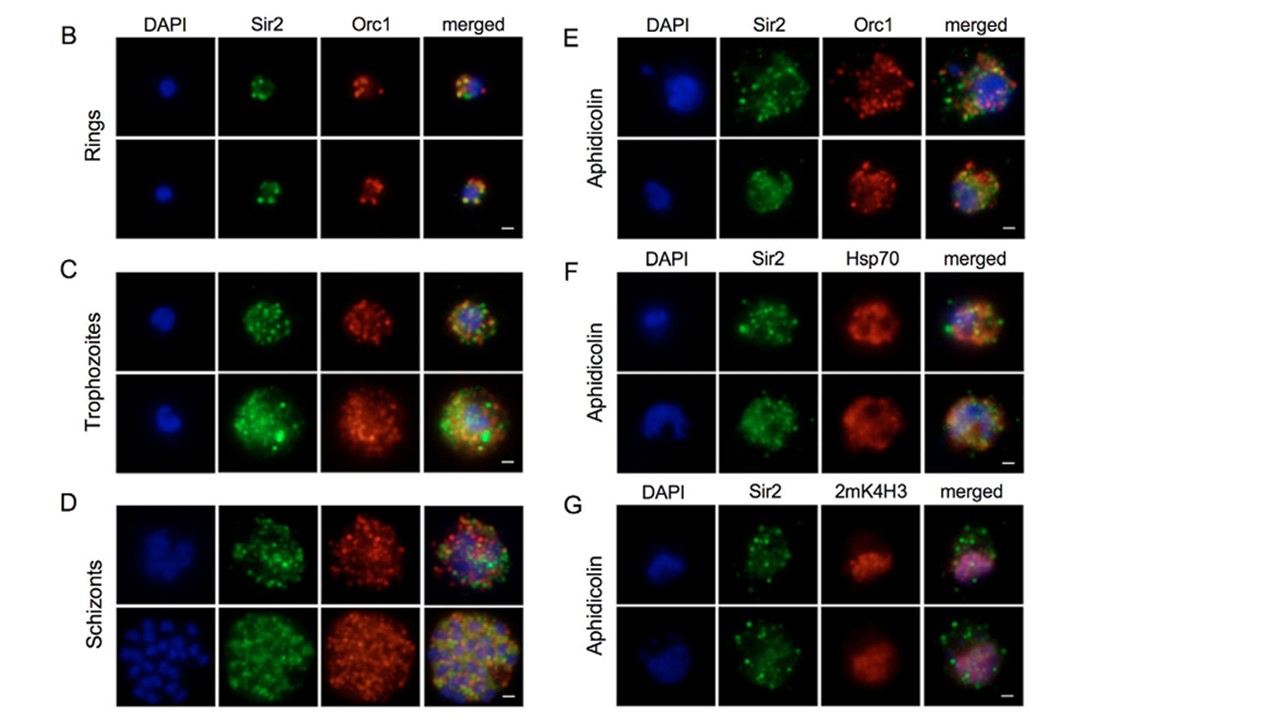Sir2 and Orc1 relocalize during the developmental cycle of P. falciparum. (A) DNA synthesis during the P. falciparum cell cycle. During the 48-hour blood stage cycle, the parasite differentiates through ring [between 0- and 18-hours post-invasion (p.i)], trophozoite (18- to 36-hours p.i.) and schizont (36- to 48-hours p.i.) stages. DNA replication in P. falciparum takes place in the trophozoite stage; it peaks at 30 hours and can be blocked by adding aphidicolin to the culture medium. Nuclear division occurs by schizogony, leading to the production of 16-32 merozoites; these are released in the bloodstream and can initiate a new cycle by invasion of a new red blood cell. (B-D) IF analysis of Sir2 (green) and Orc1 (red) during the blood-stage cycle. (B) Ring stages display a punctate pattern at the nuclear periphery. (C) In the trophozoite stages, anti-Sir2 and -Orc1 antibodies reveal an apparent increase of both protein levels, and an additional punctate and diffuse pattern inside and outside of the nucleus. (D) The schizont stage, Sir2 and Orc1 seem to relocalize at the nuclear periphery. (E-G) Double-labelling IF using parasites cultivated with aphidicolin for ~24 hours. (E) Aphidicolin-treated parasites demonstrate that the redistribution of Sir2 (green) and Orc1 (red) occurs prior to initiation of DNA replication. (F) Labelling with an anti-mouse Hsp70 (red) revealed that Sir2 (green) is displaced into the cytoplasm of the parasite before Sphase. (G) Histone H3 (dimethyl K4, 2mK4H3; red) remained associated with the nucleus. Nuclei were detected by DAPI staining (blue) in all the figures. Scale bars: 1 μm. Mancio-Silva L, Rojas-Meza AP, Vargas M, Scherf A, Hernandez-Rivas R. Differential association of Orc1 and Sir2 proteins to telomeric domains in Plasmodium falciparum. J Cell Sci. 2008 PMID: 18525026.
Other associated proteins
| PFID | Formal Annotation |
|---|---|
| PF3D7_1203000 | origin recognition complex subunit 1 |
| PF3D7_1451400 | transcriptional regulatory protein sir2b |
